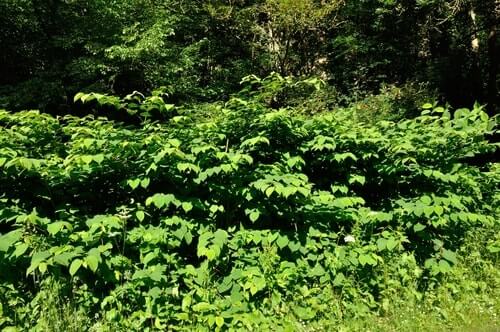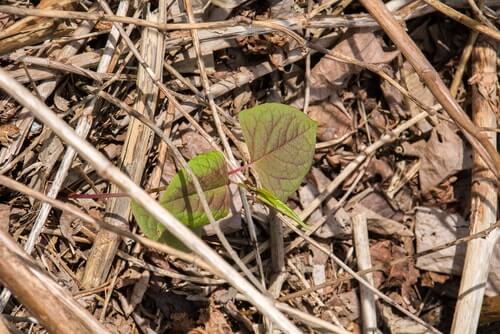Is Japanese Knotweed poisonous to dogs, cats, humans? These and other myths are addressed by South Wales Japanese Knotweed
There are many myths about Japanese Knotweed and although it is a wild invasive weed that grows extremely quickly, a myth is a myth. Green Leaf Remediation address the common myths and scare stories regarding Knotweed.
Japanese Knotweed is a perennial weed that grows and spreads quickly if not controlled. The weed suppresses all other plants growing around it from its crown and rhizomes (root system) that spread extensively underground. The shoots die off above ground in the winter and re-emerge above ground again in late spring, early summer. Any well-established shoots can grow over 9ft high and can colonize the soil within a few years. There are many articles that say you can kill the roots with chemicals, however, you need an NPTC qualified person to use any chemicals due to new legislation which covers the control, and removal of Knotweed. There are many myths that say you can remove Knotweed by hand, however, this is an extremely difficult and intricate process and in most cases, not successful unless you use a knotweed specialist. In the height of the growing season, 60% of the Knotweed plant is its roots underground so removal is very difficult and it spreads wildly from one tiny fragment of crown or rhizome. Removing Knotweed material without considerable knowledge carries a very high risk of spreading the plant to other parts of the soil which were previously unaffected.
Is Knotweed Poisonous to Dogs, Cats and Humans?
In simple terms, Japanese Knotweed is not poisonous and harmful to dogs, cats, humans or any other animals like some other highly invasive plants. It is not harmful to touch, however, always use extreme caution when near it to avoid inadvertently allowing it to spread.
allowing it to spread.
Japanese Knotweed would probably be termed as ‘poisonous’ by developers and property owners due to its highly invasive growth, ability to spread from a tiny particle left and how difficult it is to remove completely.
Some Knotweed Myths (some of which are exploited by some contractors for financial gain)
- “It will grow through solid concrete”
- “It will destabilise foundations”
- “It will cause structural damage”
- Property affected by Japanese Knotweed is not mortgageable
In simple terms, if the previous groundwork or construction has been completed to a sufficient standard then Knotweed will not grow ‘through solid concrete’, it will not destabilise solid foundations and it is highly, highly unlikely to ‘cause’ structural damage. In truth, these claims are misleading, to say the least, and in some cases, completely false.
However, in certain situations, if the foundations or concrete are old, poorly constructed and have pre-existing cracks or fractures within, then Knotweed will unquestionably exploit any weakness in its quest for light and water and will swiftly establish itself, whilst exacerbating the original fracture and potentially cause the structure to disintegrate.
How do I get rid of Knotweed?
There are many different methods of removing Knotweed and a Knotweed Specialist will be able to advise you of the best and most effective method.
Stem-Injection is a low impact method of removal and there is little risk of disturbing or killing the plants growing around it. The stem injection method is normally used for smaller areas of Knotweed where it has established itself amongst plants and vegetation that you want to keep. It is also a method often used when Knotweed is close to a watercourse. The stem injection method can be used in dry or inclement weather conditions and the soil cannot be disturbed following the treatment.
Foliar Spray Application is often used and is one of the most favourable control methods along with stem injection. The method is used to treat the Knotweed over several growing seasons. Dependent on how large the area of Knotweed is it is normally sprayed 2-3 times in the first year and once in the subsequent years. The chemical used is an Environment Agency approved herbicide and needs dry weather and the soil to remain undisturbed in subsequent years to be effective.
normally sprayed 2-3 times in the first year and once in the subsequent years. The chemical used is an Environment Agency approved herbicide and needs dry weather and the soil to remain undisturbed in subsequent years to be effective.
Weed Wiping Method is the leaves of the plant being wiped with a sponge that is soaked with the necessary herbicide. It is a low impact treatment and doesn’t kill or disturb the foliage surrounding it, however, its use depends on the size of the area of knotweed.
Bund / Stockpiling Method is a combined treatment using stem-injection or foliar application, followed by excavating the underground material and removing the soil and material to a different location where the emergence of ‘new shoots’ can be subjected to further herbicide application. This method is used on sites where you need the removal of the knotweed to be quick and not done over several seasons so is therefore particularly good for building plots and development sites as work can continue without delay.
Cell Burial / Root Barrier Method is a treatment used when there is adequate space on site to create a cell burial or utilising a root barrier to avert the substantial costs of transporting the soil and waste to landfill. Cell burial buries the Knotweed waste to a minimum depth, or if encapsulated within a geo-membrane it can be closer to the surface of the ground. Root barriers can be installed both vertically and horizontally when there is a risk of cross-boundary contamination. Again, a method most often used on development sites when construction work needs to start quickly.
Excavation & Removal Off-Site is a legitimate and swift control option which has its advantages for development sites if done correctly, however, a lot of Knotweeds Specialists are not advocates of it as it raises significant logistical challenges. The challenges being there is an extremely high risk of the Knotweed spreading as well as the cost to safely transport the material to a designated landfill site. There is also a considerable duty of care requirements under the Environmental Protection Act (EPA) 1990. In summary Excavation & Removal should only be used as an absolute last resort.
Green Leaf Remediation Specialists covers the whole of South Wales (including Swansea, Cardiff and Newport), West Wales up to North Ceredigion & Powys and throughout South Glamorgan & Gwent. We also carry out contracts in the West Country, as far North as Shropshire and into the Midlands & Birmingham areas.
We are a fully qualified Japanese Knotweed Certificated Surveyor (JKCS), family run business We specialise in controlling Japanese Knotweed, other invasive plant species and ‘general nuisance weeds’ which are found in the UK for residential premises and land development sites.
We also offer tree services, such as pollarding, crowning, pruning, felling, through our NPTC chainsaw operators, all of whom possess a vast amount of experience within the forestry industry.
Our Qualifications & Accreditations include:
- City & Guilds NPTC Level 2
- Principles of Safe Handling & Application of Pesticides (PA1/PA6)
- Principles of Safe Handling & Application of Pesticides near water (PA6AW)
- Herbicide Stem Injection
- Property Care Association
- The Control & Eradication of Japanese Knotweed Surveyor’s Training Course
- Qualified Technician (PCAQT) in Japanese Knotweed
- Accredited Surveyor in Japanese Knotweed
Whilst there are many contractors who operate within the UK weed control industry who are legitimate, knowledgeable and thorough professionals, there are regrettable lots of companies who claim to have the experience, qualifications and accreditations to ‘eradicate’ / ‘eliminate’ Japanese Knotweed at low cost. Nonetheless, we would advise anyone to exercise caution and to ensure that the contractor/company you enlist to carry out the control programme are qualified to do so and they abide by the industry codes of practice.
Visit our main website for advice on knotweed. Alternatively, give us a call on 01269 591651 or 07531 142316 and one of our experts will be able to answer any questions you may have and to arrange a site visit.
